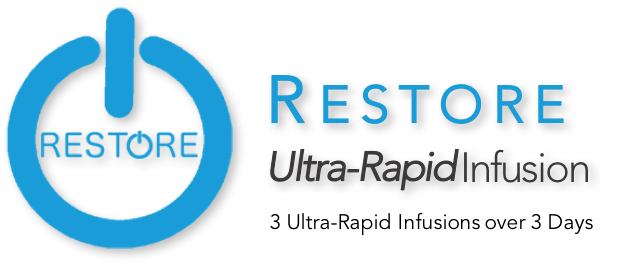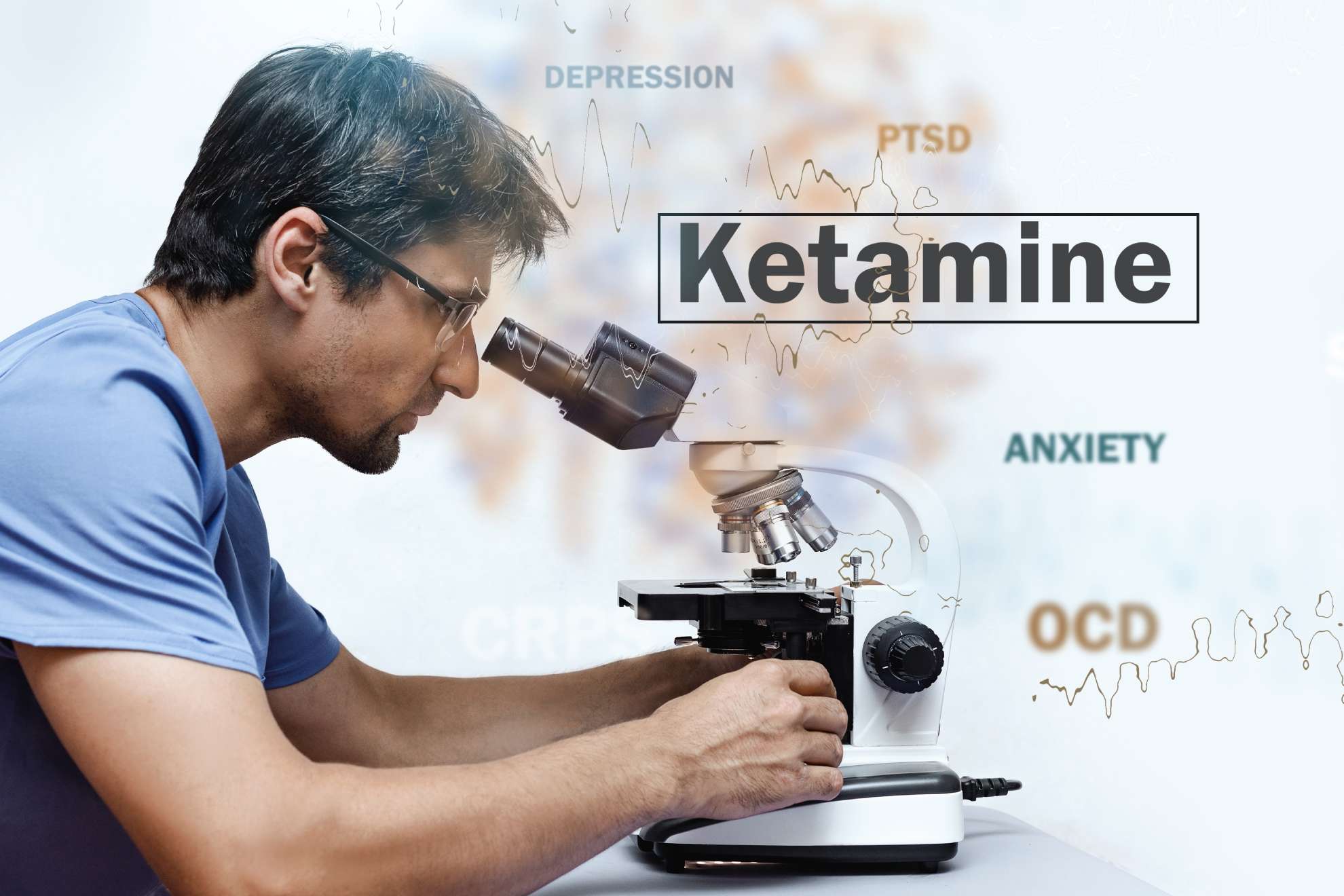Open the door to a New Life with...
Learn About The RESTORE Ultra-Rapid Infusion Difference...
Restore | Reboot | Recover...with RESTORE

The RESTORE Ultra-Rapid Infusion Difference

The RESTORE Ultra-Rapid Infusions are uniquely different from the "standard ketamine infusion" developed years ago. It is the most advanced formulation of therapy available that our clients find is not only more effective than the "standard" ketamine infusion; but when enhanced with our unique protocol it can last 6 times longer and need fewer "booster" infusions than standard ketamine infusions do. And the beneficial results can begin in just minutes to hours after the first infusion.
We have accomplished this remarkable advancement through years of clinical investigation and application. In addition to metabolic and genetic optimization of each patient we see, the RESTORE infusion process is a unique combination of ketamine and magnesium additives to make it more effective, that it is then administered by our physicians using a proprietary infusion protocol to provide the optimal blood levels for a longer period of time. Our clients choose RESTORE because they know it is faster acting, more effective and longer lasting than a regular ketamine infusion. And the beneficial results can begin in just minutes to hours after the first infusion.
If you’ve suffered for years and given up hope of ever finding relief, then the RESTORE Ultra-Rapid Infusion can almost sound too good to be true. But the number of patients receiving this revolutionary new therapy is growing rapidly. Today, almost 20 years after the breakthrough discovery at Yale, the next generation of ketamine therapy - Restore Ultra-Rapid Infusions - are finally starting to reach the patients who need it most.
We understand that living with Chronic Neuropathic Pain, Fibromyalgia and Depression can be difficult, but considering RESTORE Infusion Therapy® is a step in the right direction. Choosing RESTORE is a decision you and your doctor make together. And you’re not alone. RESTORE Ultra-Rapid Infusion therapy has been used to treat hundreds of patients all across the country and internationally.


Why RESTORE Ultra-Rapid Is So Effective
It's All About The "Disconnected" Brain
There Is A Reason Why Current Medications Don't Work Well
If your current prescription medications are falling short, recent discoveries in brain imaging studies reveal a new treatment and why it might help.
Medications are a common and sometimes effective treatment for depression, migraines and Fibromyalgia but they are far from perfect. In fact, in some cases, our current medications have proven to be no better than a sugar pill or placebo, and some patients don’t respond to any of the drug options currently available.
I've Tried Everything And... Nothing Works!
Even after over 50 years of medical research, prescription medications have not been very effective in treating most people suffering from depression, migraines, Fibromyalgia and other forms of chronic pain. These limited treatment options represent a huge clinical challenge, and many people continue to struggle.
From the time drugs were first developed back in the 1950’s to today, they have all worked through similar biochemical actions. The most commonly known and prescribed class of drugs is the selective serotonin reuptake inhibitor, or “SSRI”. These drugs, which include the brands Prozac, Zoloft, Paxil and Lexapro, attempt to regulate the amount of serotonin, a brain chemical called a neurotransmitter that carries signals between neurons and is thought to regulate mood. The assumption being that if you could increase the amount of serotonin (or dopamine or norepinephrine) available your symptoms would improve.
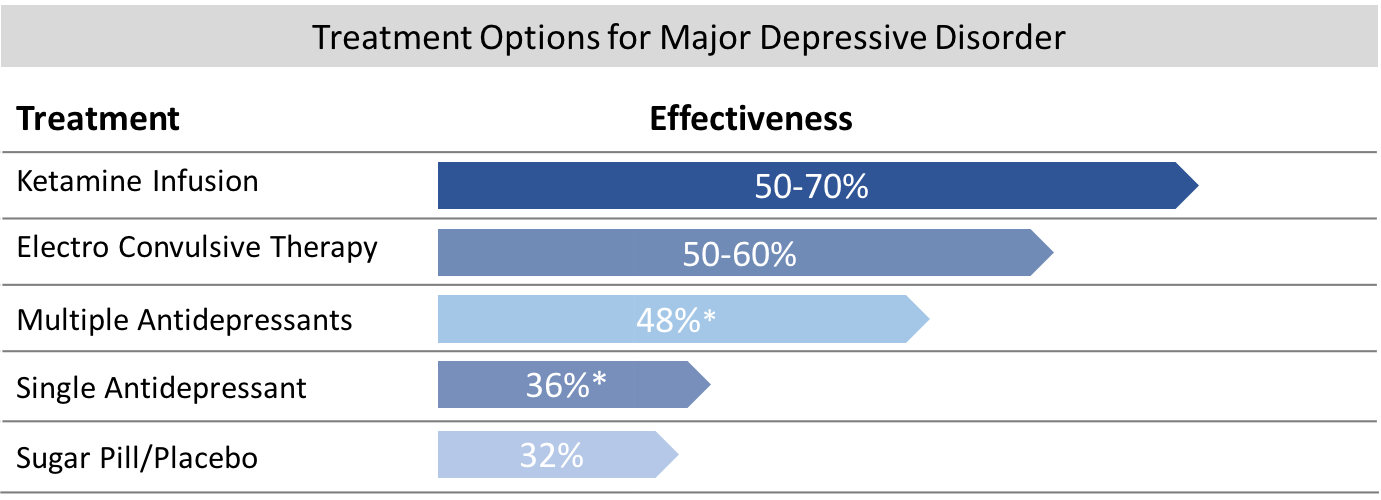
Unfortunately, they have not been as helpful as we had hoped for many people. And the rate of response to them is not as high as we need it to be. Studies have shown that only 1 in 3 patients respond to any single SSRI. And if they do respond, it can take several weeks or months before improvement is seen. Even more aggressive new treatments to combat mood disorders such as transcranial magnetic stimulation (rTMS) is only about 38% effective and even the older “gold standard” treatment of psychiatry, electroconvulsive shock treatment (ECT) is not much better. It is only effective for about 50% of patients.
Why Haven't We Been Able To Do Better?
The answer to that question may be becoming apparent with new cutting-edge research and brain imaging studies showing how the brain works. Until now, treatments for depression with antidepressants assumed that low levels of brain neurotransmitters like serotonin and dopamine were the cause of depression. But what if we were wrong?
Important findings emerged in the late 1990s with the observation by researchers that brain tissue in critical areas of the brain was reduced in people who had been under prolonged stress and in combat veterans who had developed depression and PTSD.
Investigators at Stanford University suggested that stress might cause the “death” of neurons, suggesting that the critical brain size reductions seen in patients under stress and those with depression and PTSD might reflect the loss of nerve cells.
These new findings began to suggest that the old theory about low serotonin causing these illnesses may be incorrect. But why were these vital areas of the brain “shrinking” and getting smaller and smaller?
The "Disconnected" Brain
The answer to that question was found with the development of a new way type of MRI study called Diffusion Tensor Imaging or “DTI”. Using DTI techniques researchers have could examine these areas and the “neural network connections” around in much greater detail.
With this new way of looking at the inner workings of the brain, it became apparent that these critical neural circuits, which play an important role in the development of major depressive disorders, fibromyalgia, and even migraine headaches, were becoming “disconnected” and isolated in some way.
What they saw were microscopic changes occurring between the white matter (wiring-neural circuit pathways) of higher and deeper layers of the brain known as the cortical–subcortical circuits, leading to a type of “disconnection syndrome” between those regions. This decrease in “connectivity” linking the various critical areas of the brain appears to be directly involved in the development of various disorders, including depression, anxiety and PTSD.
The loss of these connections means that various areas of the brain may no longer be able to communicate information effectively and become stuck in a sort of continuous “loop”. Almost like a computer program that freezes and won’t work correctly. It now appears that this “disconnection” in the brain’s wiring network and loss of communication is what was responsible for low neurotransmitter levels.
By losing those connections, the repetitive circuits may then only communicate limited signals, like continuous thoughts and feelings of depression, anxiety, or pain. We now suspect that as these important connections are lost or “disconnected” , people may begin to feel depressed, and anxious or start to experience pain, increased sensitivity, and headaches. Often, they also report having difficulty concentrating or remembering important information. The result is that everyday life can become difficult and less meaningful. Friends, family, and things they used to enjoy no longer seem to bring them pleasure.
It can seem almost as if someone has slowly and methodically "turned off" all the light switches in a big house, and now the house becomes cold, uncomfortable, dark, and gloomy
If that is the case, the question then becomes: can you restore those lost connections?
New Options to "Reboot and Reconnect" the Brain
New research is showing additional evidence supporting the “disconnection syndrome” theory and suggesting that the connections can be “restored or rebooted”.
Part of that research was the discovery that a 50-year-old medication commonly used for anesthesia had been found to have some very remarkable “side effects”. Researchers were astonished when they found that following the intravenous administration of ketamine, they saw a rapid “reconnection” of the brain network. More than that, they discovered that following the treatment, brand-new nerve connections began to develop almost immediately.

Ketamine was found to have this unusual effect by stimulating a brain “nerve growth” factor known as BDNF which could reverse some of the disconnections in minutes. That small study conducted at Yale also served to establish an arbitrary “standard” for ketamine infusions in the treatment of mood disorders. The standard was, and is, to this day - "administer 0.5mg/kg of ketamine over 40 minute" based on body weight.
While the effects of ketamine were astounding and it was truly remarkable that the brain could be “reconnected” so quickly, there was a catch. After a single infusion, the “rebooting” only seemed to last for 3-7 days before the connections were lost and symptoms returned.
How could it be made to last longer?

The Standard Medical Model -
How Others Tried To Make Ketamine Last Longer
The Old ECT Model
 To study this, one group in Minnesota and another in New York thought that ketamine may work like another older and more aggressive form of therapy known as electroconvulsive therapy or "ECT". They knew that is usually requires 6 or more ECT sessions before a person improves, so perhaps ketamine needed to be given more than once just like ECT.
To study this, one group in Minnesota and another in New York thought that ketamine may work like another older and more aggressive form of therapy known as electroconvulsive therapy or "ECT". They knew that is usually requires 6 or more ECT sessions before a person improves, so perhaps ketamine needed to be given more than once just like ECT.
To test this hypothesis, they began to administer 6 ketamine infusions, one every other day for 2 weeks, just like they would for ECT. What they found by doing that was that beneficial effect could be extended to 1 month before another infusion had to be given. Obviously, that was better than 3-7 days, but patients then needed ongoing “booster infusions” every 4 weeks after that to make it last.

While 6 infusions given every other day for 2 weeks did improve the benefits of ketamine substantially, many patients found it difficult to return each month for "boosters". We thought it could be better and it was always a little surprising that few have had the imagination, experience or expertise administering ketamine infusions to improve on it. They either seem content with the way it works now or have not been able to move beyond those minor improvements.
We took a different approach...
Precision Medicine -
New Solutions Require New Ways Of Thinking
The New RESTORE Ultra-Rapid Approach
We knew we had to look at this in a new way to get the best results, so we took a different approach. Some people have the impression that all people with an illness like depression, fibromyalgia or migraines are alike. With that thinking, you give the same medication, in the same amount to everyone in the same way and hope they improve. Unfortunately, as we all know, it doesn’t always work well that way.
But we knew that each person is unique and different, so it was obvious that the treatment must be individually tailored to match the patient. Rather than use an old model like ECT, we used a new integrated and systems model. Using the same old methods and expecting different results never leads to new breakthroughs.
There were many factors to consider. To begin, the amount of medication needed from patient to patient can vary greatly. Based on our experience, we knew that it was critically important to achieve a certain “blood level” or effective serum concentration, also known as the effective dose for 95% of patients or (ED95), to achieve optimal results. This can be challenging, and many physicians are unaware of the optimal serum concentrations needed.
But there was even more than that to consider. It is also vitally important to account for other factors such as current medications, metabolism, body composition, ancestral heritage and genetic factors, which all play a critical role in treatment response. Precision Medicine and innovative clinical research has shown that there is a wide variation in the way people metabolize medications and this is often due to liver enzymes known as Cytochrome P450. More than that some individuals may lack acetyl-L-carnitine (LAC) or have a BDNF variant which may effect optimal treatment response. All of these factors need to be considered to have the best response.

And then, we found that it was not only important to optimize the amount of medication given, but we had to change the way it was administered. It had to be carefully adjusted to each patient, minute-by-minute, while constantly monitoring them and by adding synergistic agents; if all of that was done very carefully then, ketamine worked remarkably better and lasted much longer. Following this approach, we discovered the we could achieve better results with only 3 infusions and that they would last for 3-6 months.
Using this new “RESTORE” model and treatment protocol we have had outstanding results in people who didn’t respond to any medication, therapy, magnetic stimulation, ECT or the even the “old ECT model of ketamine administration”. The RESTORE Ultra-Rapid Infusion is the result of years of hard work. It is an advanced treatment which has been shown to enhance and restore brain connectivity, capable of establishing new neuronal connections within minutes of treatment.
You Can See The Results...

See The RESTORE Difference For Yourself
Depression
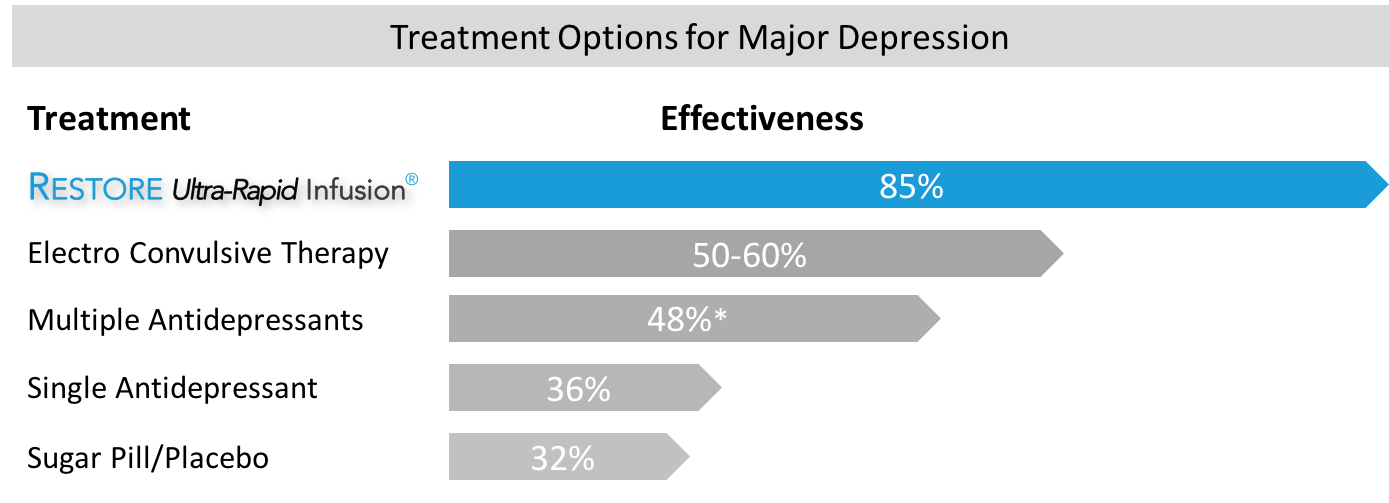
Migraine Headaches

Fibromyalgia
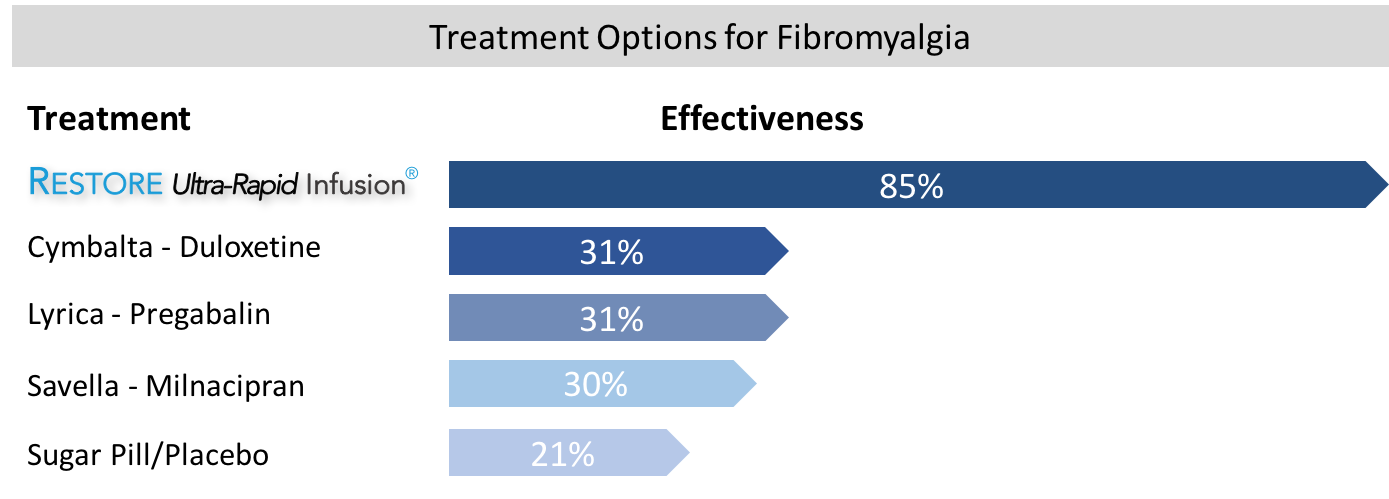
Neuropathic Pain - Including CRPS/RSD

What The Future May Hold...
The future of drug treatment for migraines, fibromyalgia and depression, as with for many other diseases, lies in the genetic code and a better understanding of how the disorder occurs. Realizing the tremendous potential of ketamine therapy, numerous pharmaceutical companies are working to develop other versions of ketamine that can be administered in other ways, including as an oral medication or a nasal mist.
Major drug companies, including Johnson & Johnson, Janssen and Allergan are stopping research into older antidepressants and rushing into the development of new drugs that they hope will come close to duplicating the rapid and remarkable benefits of the ketamine infusion.
There is little wonder why this is happening when you consider the dramatic improvements that can occur in just 24 hours after just a single infusion. No current medications or treatment that can match the seen with ketamine. While the pharmaceutical companies are trying to make something almost as good as ketamine, the results have been disappointing.
We have taken another path...
Rather than changing what we already know works well…we made it even better and longer lasting!
It may be a few years before any of these other ketamine-like treatments or other drugs are FDA-approved; but because the drug is already approved for other uses, some physicians are recommending RESTORE Ultra-Rapid Infusion therapy for their patients with migraines, fibromyalgia or treatment resistant depression now.

That is the RESTORE Ultra-Rapid Infusion Difference.
The Ketamine Research Institute and RESTORE Infusion Center — Known WorldWide
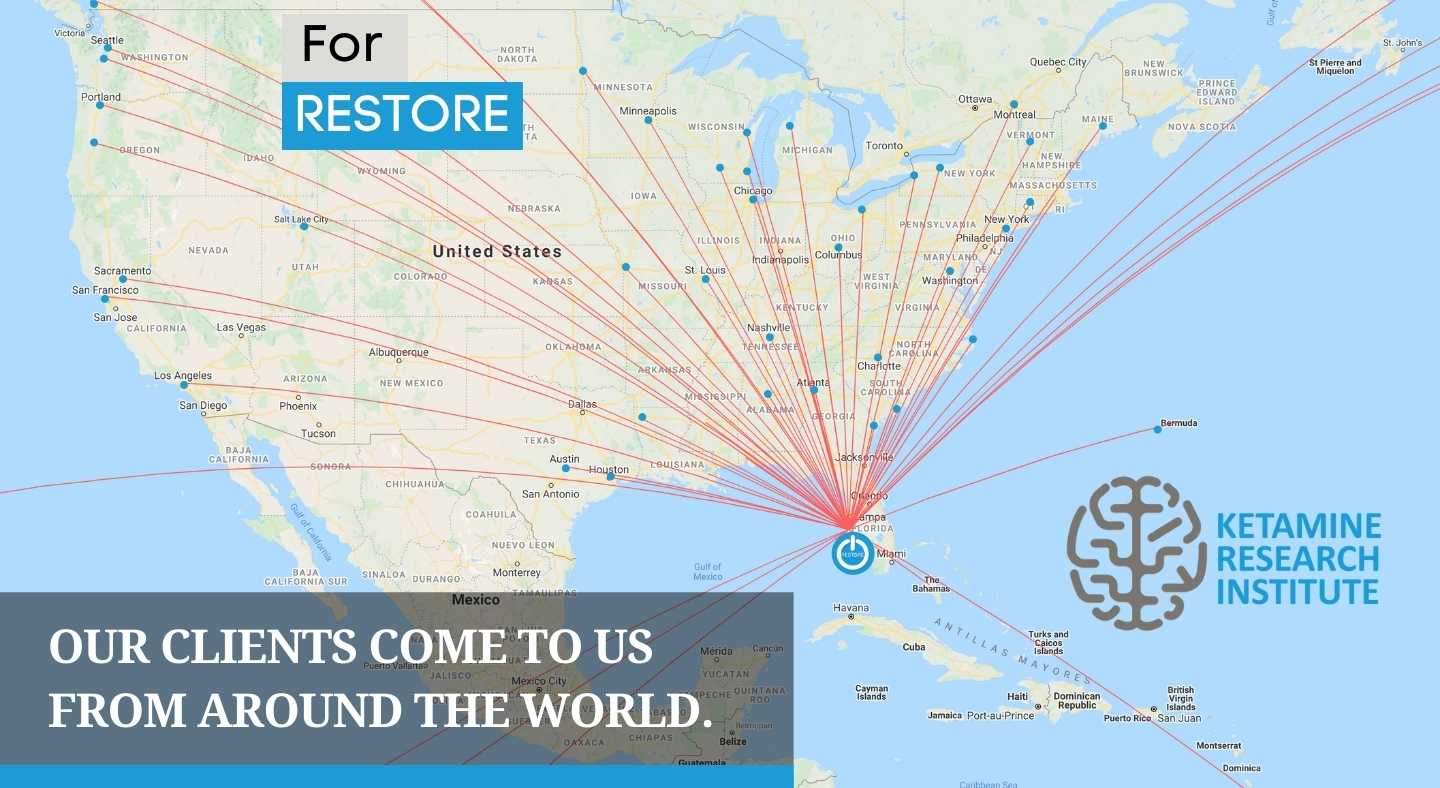 If you suffer from chronic pain or depression and have not had relief with prescription medication or other traditional treatment modalities, then the RESTORE Ultra-Rapid Infusion may be an option for you. We will be happy to provide you with an initial consultation to see if infusion therapy is right for you.
If you suffer from chronic pain or depression and have not had relief with prescription medication or other traditional treatment modalities, then the RESTORE Ultra-Rapid Infusion may be an option for you. We will be happy to provide you with an initial consultation to see if infusion therapy is right for you.
Contact us today
at 800-850-6979
“The most important breakthrough in antidepressant treatment in decades”....
Thomas Insel, MD - Director, National Institute of Mental Health



